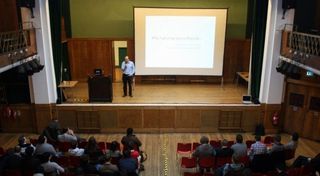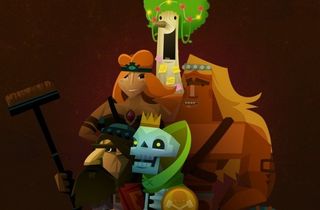World of Love 2 - a lovely indie games conference

Sexy, sexy developers. Indie developers, that is; for they were World of Love's original target audience when it was set up by Mudlark last year. The aim was for a London, UK conference that allowed indies to meet up, share “best practice” (biz-niz speak for good ideas) and talk about the cool stuff they were doing.
Having seen the reports from last year, where both Introversion's subversion and Mode 7's Frozen Synapse were shown off for the first time, and Channel 4 spoke about their commitment to commissioning games as as educational medium, I have to admit to being a little disappointed at this year's line-up. From a consumer and journalistic games viewpoint, there were no big reveals (Posterous's Ho-Ho-hukum had already been shown off at the IGDF and Evolve in Liverpool) which meant it simply wasn't as interesting as last year's event; I'm sure it still retained its usefulness for Indie developers though, and it was still a useful vignette of that scene in the UK; a continuum of unruly hair, dress developed without reference to popular culture, and second-language English, first language C++ people with amazing brains and ideas who know how to do one thing well; make games; and need to learn all the other bits, like where to sell them, how much to charge, and when to sell out.

There were three developers in the morning; Honeyslug , who showed off their Ho-Ho-kum an cutesy art-and-music title that's obviously been in search of a compelling gameplay twist since they started work on it. They mainly talked about their struggles to establish exactly what the game was about (currently it seems to be a worm-thing saving people in a 2D alien world) and then make sure everything fitted with their concept of the game, beyond having really bright, cute characters. They advocated a Good Cop, Bad Cop system of game development, with one enthusiast plugging as many ideas in as possible, and one person cutting the chaff willy-nilly. Their key concept was about enforced freedom; they feel that sandboxes like the PS3's Noby Noby boy force players to be free; whilst they pointed out that the enjoyment of “hooning around” was derived from the feeling that “there's something more important I should be doing.”
The next developer was Tak Fung , who worked in Lionhead on the Fable series before he became an Indie developer. He managed this by working mainly as a contractor, then setting aside time for his own projects - which he initially had difficulty getting off the ground, until he teamed up with a freelance art director. His recommendations for developers were not working with multiple contractors, as it's hard to maintain consistency, ensure that everyone has a range of skills, and PR effectively - submitting a video to Touch Arcade provided enough feedback to polish the game before he transferred it to other platforms. iPhone is the easiest to develop for, but barriers to entry are low everywhere.

The third team, Remode Studios were an impressive couple of recent graduates (Elle Romanos and Martin Darby) with a very business-like focus; they do projects on time and on budget, and describe themselves as a “digital production company”. They also had taken the other independent developer route and are working mainly as contractors. In this position, unlike Tak, they advocated employing reliable freelance contractors and interns (who they don't pay, sadly), and praised the Plymouth area for having a good supply of both fresh graduates, veterans of Britain's gaming hubs, and excellent quality of life. When undertaking commissions, they focus on respecting the commissioner's vision; it's their IP after all.
Their own first title, a Minesweeper-twist called Mole Control, took them eight months to develop and was release across Steam and other PC platforms; as we always hear, Steam is very easy to work with, but the challenge of varied prices, responsiveness and release schedules made other platforms more difficult. By the time they released it however, the casual market had moved to Facebook, so they licensed the game to retailers in Europe & America, and moved on. They don't see themselves, as Indies, making combat games in robot bodysuits; there's no reason making a Halo without a huge budget and a convincing fiction.
For them, as more platforms emerge, it's worth asking how they fit a player's life; will they play it on the train, at work or on the sofa? “Design is marketing - it's a holistic process.” Rather than using other people's tech, they've built their own; this was due to a lucky hire, a 20 year veteran of LucasArts, whose ability made it cost-effective. This means that they aren't held back by licensing issues and were eligible for the huge R&D tax credits that _are_ available to tech companies. It also allowed them to branch out into making non-games simulations for companies. They also admitted a certain weakness, in that they don't understand direct marketing or web advertising.
The biggest gaming news, reviews and hardware deals
Keep up to date with the most important stories and the best deals, as picked by the PC Gamer team.

After a short break for coffee and banter, the superb Alice Taylor stood up. Alice, if you don't know her, is a veteran of the dotcom boom and bust who has just quit as the games commissioning editor for Channel 4. Her new project is informed by games, particularly by the dressing-up involved in World of Warcraft; she's working on making luxury bespoke dolls using rapid prototyping technology. “I'm all about social change”, she said, “I really like to break walls.” She portrayed the toy industry as a bastion of social conservatism, rife with sexism and commercialism when it should be about play, and she wants to change it.
Her experience on StorTroopers , an avatar project she started that had a huge userbase in Brazil and WoW, made her realise that there was a market niche for bespoke dolls for a networked generation. “WoW is a giant dressing up and shopping game”, she said, and pointed to the WoW figureprints, Guild Wars marriage kits and hugely expensive SoulDoll Lineage II figures as proof that the market is there; people will pay over $100 for a blouse and jacket combo for their SoulDoll figurine on Etsy. Yet 95% of the toy manufacturing is in China, with a downward spiral just to compete on price (a Barbie costs $15 in the shops but 8c to make); rapid prototyping offers a way to compete, at the moment just with the luxury products.

Dr. Sam Redfearn, a professor at the University of Galway and solo-developer of the obscure Dark-wind , was equally inspirational. He talked about Dark-wind, “possibly the world's best MMO turn-based, physics-based, post-apocalyptic , tactical rpg-wargame vehicular combat”, a riff off Car Wars and Dark Future, inspired by the “persistent digital minions” of Championship Manager. Following years playing CRPGs and MUDs, his PHD was in topographic photography, which he moved into collaborative virtual environments from. He was part of an online community of tiny MMO developers - two guys went off to make Minions of Mirth, one guy gave up his house and lived in his car trying (then succeeding) to finish his game. One full-time worker even experimented with sleep deprivation; he'd work all night then wake up on his keyboard, fall asleep in meetings, and so on... until he got fired. Sam was one of the rare few who finished his project.
Dark-Wind is different from many MMOs - travel time between the two hub cities is in real-time, taking up to 30 hours, and your minions are affected by ageing, training, weaknesses, permanent addictions, death and injuries; in this sense it's closer to Necromunda or Blood Bowl than a normal RPG. He pulls his story out of maths and simulation rather than written narrative, and uses committed community members to work on bits he doesn't have time for - even the art is bought in (from TurboSquid) and the game support is mainly automated services backed up volunteer Marshals with his phone number. He left us really wanting to try it.

After everyone shared a bizarre Swedish packed lunch, Preloaded's Phil Stuart talked about the mechanics of making people find your games. First he offered a sneak peek of his upcoming game “The End”, a platform puzzler that helps teens deal with death and religion. Then he gave his rules for game dissemination. First, determine why you're making it (marketing, education, fame) so you can determine what success looks like. Then you can work out the audience, and hence the genre, platform and level of complexity. Then you can work how it's going to be found and how you're going to drive traffic to it.
His tips for driving traffic are:
Work with pirates. They try to encourage it for their free games it's free distribution. They create single flash files that pirates can stick on their site easily. Bizarrely, they find that 4399.com works well, as sites with the word “game” in the url get banned by schools.
Integrate with portals - use the APIs for Miniclip & Kongregate, and they'll promote your game for you, as well as providing more reasons (e.g. achievements) for people to play it.
Adapt to the host. Create multiple configurations of the game. One that adapts to the host (with the APIs built in), one for pirates, one with an HTML surround.
Listen to your players. Involve your community early, and take feedback from the Kongregate beta list.
Stick around when you've released the game, follow the message boards and the forums, and watch out for recurring problems - but don't take the abuse personally.
Use analytics. Set it up right and watch it live to check it's working. If you can, correlate your views versus completions for levels to determine difficulty spikes.
Be web friendly. You want your game to be the best SEOd destination for your game name. Use unique names, numbers, a great description, use a standardised url when sharing, create thumbs & icons for ease of distribution, and agree on your hashtags for Twitter. As a proof of success, he showed that their 1066 game for Channel 4 is actually above Wikipedia's entry for 1066!
There was then a mostly uninformative interview with sex-game manufacturer (joke!) Charlie Knight of www.charliesgames.com - the only memorable question was “Bearing in mind you made a game with a disembodied dog's head and giant cocks everywhere, is there any prototype you've been ashamed of?”
Next we saw Oxford's Mode 7 games , makers of the eagerly-anticipated-by-me Frozen Synapse presented by Ian Hardingham. This time round he showed off both how new maps are drawn (basically it can be done in Paint), how they're randomly generated and how their single-player missions work around this generative process whilst maintaining consistent objectives. Very clever, and a great idea for other games.

Ill Rob Fearon of Retro Remakes had a bit of a fever-ramble, but spoke passionately about asset-sharing; he admitted that “none of my games includes more than 100 lines of code, because I'm shit” but pleaded with other developers to go open-source as even if an asset was of no use to you, it might be of use to other developers.
Call me a cynic but Sophie “Linear Blog” Houlden's talk about SURPRISE was mostly obvious, though presented in an enticing manner (this year she used Powerpoint rather than reading it off a PSP), mentioning geek keywords like Ninjas & Science lots. Simply put she said that surprise was a good tool for keeping your game fresh, as long as you keen in mind players' variety of reaction, engineer their expectations effectively and allow them room for finding surprises themselves. You can generate surprise through the narrative, broken consistency and false endings. She also defined the unit of surprise as a “wow” and pointed out almost all games involve attempting to kill the player.

Whilst we were waiting for the last speaker, we had rapid fire rants. Richard Perrin spoke about hating people who say “If I wanted a story, I'd read a book” and pointed to Vespers, Digital: A Love Story, Mirror Stage and Looming as counter-examples. Veteran James Wallis talked about Collectable Card Games, and consultant Nicholas Lovell talked about the importance of varied price points - free for most people, normal price for a few, limited edition and uber-editions for fans and uber-fans. Rock, Paper, Shotgun also ran a panel talking about genitals in games.
I have to admit to diving out at this point, despite the last talk being given by the beautifully-designed Laser Squad alike Skulls of the Shogun developer Borut. His laggy Skype feed was being projected on a huge screen behind the stage, and I have a pathological fear of giants with connection issues; also his accent combined with the tinny speakers to sound like a rather irritating Steven Hawking.
World of Love is a great conference because it comes from so many angles; business, development, marketing, history and unintentional comedy. That said, to keep going, next year's conference will need a tighter focus; not bigger speakers, but more research by the organisers so that the new games we're shown are genuinely amazing, and the tips for developers are more organised and better delivered. Many of the talks were intensely personal, which made for great anecdotes but sometimes didn't provide us with many lessons for either game development or game appreciation.
Most Popular

